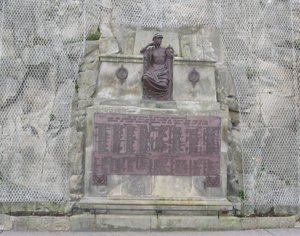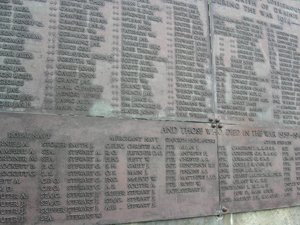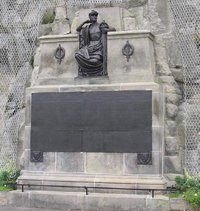Showcase result
Lossiemouth
Town or City: Lossiemouth
County: Moray
Country: Scotland
WMT Reference Number: WM4225
Value of grant: £7500.00
Type of memorial: Freestanding
Type of work: Conservation and repair
Grant scheme: Small Grants Scheme in Scotland
Year: 2011
UKNIWM reference number: 8718
 Lossiemouth war memorial is located on Pitgaveny Street, built into the cliff face 100 metres from the sea and opposite where the old railway station used to be. The memorial was described by the ‘Northern Scot’ in 1922 as ‘”The body of the memorial, which is built into a part of the rock opposite the station, is constructed of polished freestone from Greenbrae with a heavy moulded base about 12 feet wide. It is surmounted by an entablature upon which a bronze panel with the names of the fallen inscribed is affixed. A bronze figure representing ‘Victory and Peace’ rests on the top. In his left hand is a sword pointing downwards. Both arms rest on the entablature.” The memorial originally recorded the names of those killed in World War I, but World War II names were added at a later date.
Lossiemouth war memorial is located on Pitgaveny Street, built into the cliff face 100 metres from the sea and opposite where the old railway station used to be. The memorial was described by the ‘Northern Scot’ in 1922 as ‘”The body of the memorial, which is built into a part of the rock opposite the station, is constructed of polished freestone from Greenbrae with a heavy moulded base about 12 feet wide. It is surmounted by an entablature upon which a bronze panel with the names of the fallen inscribed is affixed. A bronze figure representing ‘Victory and Peace’ rests on the top. In his left hand is a sword pointing downwards. Both arms rest on the entablature.” The memorial originally recorded the names of those killed in World War I, but World War II names were added at a later date.
 The memorial’s location so close to the sea and the weather and salty air associated with it took its toll on the memorial in the 90 years since its creation. Therefore, in 2011 a grant of £7,500 was awarded under the Small Grants Scheme in Scotland. The project centred on the treatment of the bronze which included cleaning with minimal cleaning methods of deionised water, pH neutral soap and bristle brushes. This was sufficient to remove any deposits from the bronzework but is not too abrasive as to remove the original patina or disturb the surface of the metal. The bronze was chemically re-patinated; this is a controversial area of metal conservation. However, while in many cases it may not be considered appropriate to re-patinate historic monuments and sculptures, in the case of war memorials there is a different prevailing attitude due to the importance of their commemorative function. Following re-patination the bronze was waxed; this protects the bronze from pollutants and water which cause corrosion. This wax needs to be regularly removed and re-applied as part of the maintenance of the memorial to ensure its protection.
The memorial’s location so close to the sea and the weather and salty air associated with it took its toll on the memorial in the 90 years since its creation. Therefore, in 2011 a grant of £7,500 was awarded under the Small Grants Scheme in Scotland. The project centred on the treatment of the bronze which included cleaning with minimal cleaning methods of deionised water, pH neutral soap and bristle brushes. This was sufficient to remove any deposits from the bronzework but is not too abrasive as to remove the original patina or disturb the surface of the metal. The bronze was chemically re-patinated; this is a controversial area of metal conservation. However, while in many cases it may not be considered appropriate to re-patinate historic monuments and sculptures, in the case of war memorials there is a different prevailing attitude due to the importance of their commemorative function. Following re-patination the bronze was waxed; this protects the bronze from pollutants and water which cause corrosion. This wax needs to be regularly removed and re-applied as part of the maintenance of the memorial to ensure its protection.
 The stonework was cleaned with a biocide, water and non-metallic brushes. Due to the nature of the stone it is not possible to remove all the staining without using more aggressive techniques which may cause problems in the long-term. The stonework’s current condition retains its patina of age and highlights the history of the memorial and is in-keeping with the surrounding rock. Open joints on the memorial and these were re-pointed with lime mortar. The later addition wreath rail had corroded, and so was replaced.
The stonework was cleaned with a biocide, water and non-metallic brushes. Due to the nature of the stone it is not possible to remove all the staining without using more aggressive techniques which may cause problems in the long-term. The stonework’s current condition retains its patina of age and highlights the history of the memorial and is in-keeping with the surrounding rock. Open joints on the memorial and these were re-pointed with lime mortar. The later addition wreath rail had corroded, and so was replaced.
The creation of a memorial was first suggested in 1919 and the design was by sculptor Mr Percy Portsmouth. The memorial was erected in 1922 and undertaken by a local builder, Mr H Smith. The memorial was dedicated on Sunday 20th August 1922 by the Laird’s wife, Mrs Brander-Dunbar. The World War II names were unveiled on 13th November 1953. The First World War names are from the Seaforth Highlanders and Royal Naval Reserves. The Second World War names represent the Royal Navy, Merchant Navy, Seaforth Highlanders and other services; making the seaside location even more poignant.
The inscriptions on the memorial read:
“To the memory of the men of Lossiemouth
and the landward part of the parish of Drainie who died in the
service of their country during the War 1914-1919 – not in vain”
“And those who died in the War 1939-1945”.
Further information
War Memorials Trust reference WM4225
UK National Inventory of War Memorials: 8718
If you have a concern about this memorial please contact the Trust on conservation@warmemorials.org


